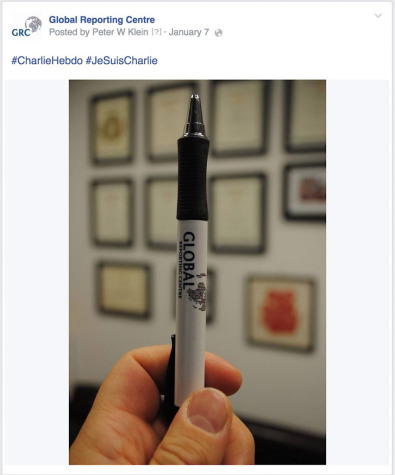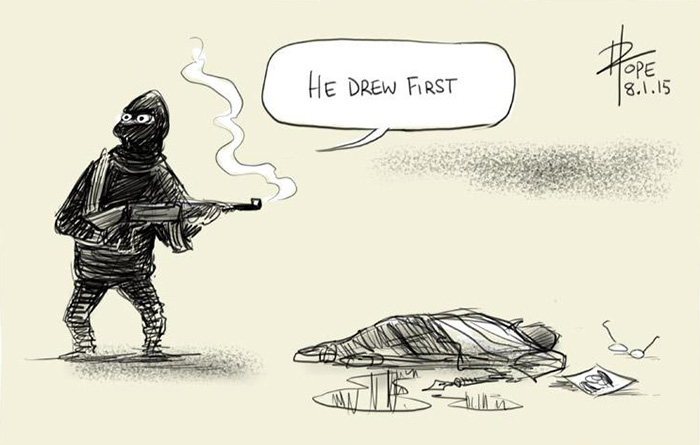After the attacks that killed 12 people at the office of the magazine Charlie Hebdo, social media and the power of ideas in journalism have been on the minds of many.
Without the intention of directly throwing myself or any of my colleagues under the bus, the majority of journalists today are not hurt by wars or the combats they report, but rather the ideas they express, and how they express them. To depict a sensitive subject such as someone’s religion in an irreverent, satirical way is an expression of our freedom of speech, but when it concludes in a mass shooting then at some point, that perhaps it’s time for a re-evaluation. Or, at least, we know
something has gone terribly wrong. Charlie Hebdo and social media proved the power of ideas, and the accessibility to broadcast them virtually.
Technology is human invention and innovation. Technology can be new ways of doing the things we’ve always done, or new ways of doing new things we’ve never thought of before.
 Language is an invention
Language is an invention that’s been around for a while, so is journalism, as a
medium of communication. But the technology of communication has undergone a huge transformation thanks to widespread social media, the ability to exchange information across borders within seconds, knowing the details of people’s lives in 140 characters without ever physically meeting them in person.
Alfred Hermida, award-winning journalist, digital news pioneer and author of the book
Tell Everyone: Why We Share and Why it Matters, says that social media inherently favours guerilla warfare, because it is free, open to anyone, has the potential for global reach, and without the centralized control structure can be a more direct means of spreading information.
“The real-time nature of social media offers a tactical propaganda advantage to terror groups,”
writes Hermida. “They can try to seize the news agenda by sending immediate reports and photos from the scene of an attack, before the media or the authorities even have time to evaluate what has happened.”
In the days following the attack on Hebdo, I’ve personally seen cartoons depicting the event, photographs of my friends holding up pens and pencils in solidarity, all over my Facebook feed and other social sites, showing the social media after-effect and how it’s resonated in the digital sphere of my homefeed. Similarly to how the cartoons circulated the world, will these images of solidarity have another resounding effect? If so, what is that going to look like?
Joel Simpson from the LA Times wrote something about this that sums up our most important objective at this moment in time, that “one can acknowledge the anger and upset of those who see their fundamental religious beliefs mocked while also affirming that we must redouble our efforts to defend freedom of expression around the world. Freedom of expression is not only a fundamental human right; in the Internet era, information is a shared global resource that must be available equally to all.”
Journalists face dangers like Charlie Hebdo every day, and as we’ve seen,
terrorism did not kill their ideas. Those images continue to circulate our media channels, as inflammatory as they were.
 Language is an invention that’s been around for a while, so is journalism, as a medium of communication. But the technology of communication has undergone a huge transformation thanks to widespread social media, the ability to exchange information across borders within seconds, knowing the details of people’s lives in 140 characters without ever physically meeting them in person.
Alfred Hermida, award-winning journalist, digital news pioneer and author of the book Tell Everyone: Why We Share and Why it Matters, says that social media inherently favours guerilla warfare, because it is free, open to anyone, has the potential for global reach, and without the centralized control structure can be a more direct means of spreading information.
“The real-time nature of social media offers a tactical propaganda advantage to terror groups,” writes Hermida. “They can try to seize the news agenda by sending immediate reports and photos from the scene of an attack, before the media or the authorities even have time to evaluate what has happened.”
In the days following the attack on Hebdo, I’ve personally seen cartoons depicting the event, photographs of my friends holding up pens and pencils in solidarity, all over my Facebook feed and other social sites, showing the social media after-effect and how it’s resonated in the digital sphere of my homefeed. Similarly to how the cartoons circulated the world, will these images of solidarity have another resounding effect? If so, what is that going to look like?
Joel Simpson from the LA Times wrote something about this that sums up our most important objective at this moment in time, that “one can acknowledge the anger and upset of those who see their fundamental religious beliefs mocked while also affirming that we must redouble our efforts to defend freedom of expression around the world. Freedom of expression is not only a fundamental human right; in the Internet era, information is a shared global resource that must be available equally to all.”
Journalists face dangers like Charlie Hebdo every day, and as we’ve seen, terrorism did not kill their ideas. Those images continue to circulate our media channels, as inflammatory as they were.
Language is an invention that’s been around for a while, so is journalism, as a medium of communication. But the technology of communication has undergone a huge transformation thanks to widespread social media, the ability to exchange information across borders within seconds, knowing the details of people’s lives in 140 characters without ever physically meeting them in person.
Alfred Hermida, award-winning journalist, digital news pioneer and author of the book Tell Everyone: Why We Share and Why it Matters, says that social media inherently favours guerilla warfare, because it is free, open to anyone, has the potential for global reach, and without the centralized control structure can be a more direct means of spreading information.
“The real-time nature of social media offers a tactical propaganda advantage to terror groups,” writes Hermida. “They can try to seize the news agenda by sending immediate reports and photos from the scene of an attack, before the media or the authorities even have time to evaluate what has happened.”
In the days following the attack on Hebdo, I’ve personally seen cartoons depicting the event, photographs of my friends holding up pens and pencils in solidarity, all over my Facebook feed and other social sites, showing the social media after-effect and how it’s resonated in the digital sphere of my homefeed. Similarly to how the cartoons circulated the world, will these images of solidarity have another resounding effect? If so, what is that going to look like?
Joel Simpson from the LA Times wrote something about this that sums up our most important objective at this moment in time, that “one can acknowledge the anger and upset of those who see their fundamental religious beliefs mocked while also affirming that we must redouble our efforts to defend freedom of expression around the world. Freedom of expression is not only a fundamental human right; in the Internet era, information is a shared global resource that must be available equally to all.”
Journalists face dangers like Charlie Hebdo every day, and as we’ve seen, terrorism did not kill their ideas. Those images continue to circulate our media channels, as inflammatory as they were.

